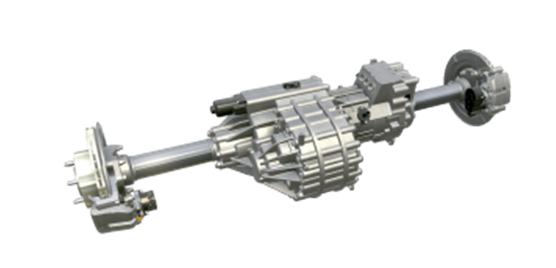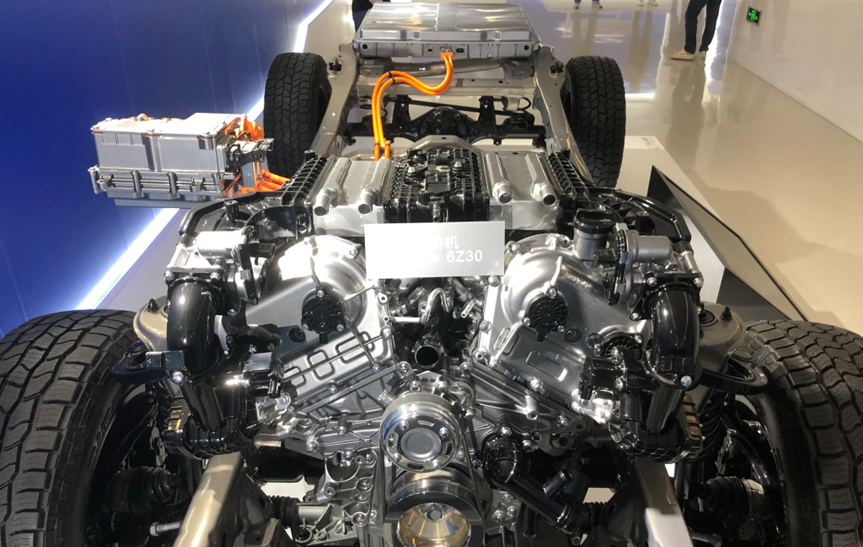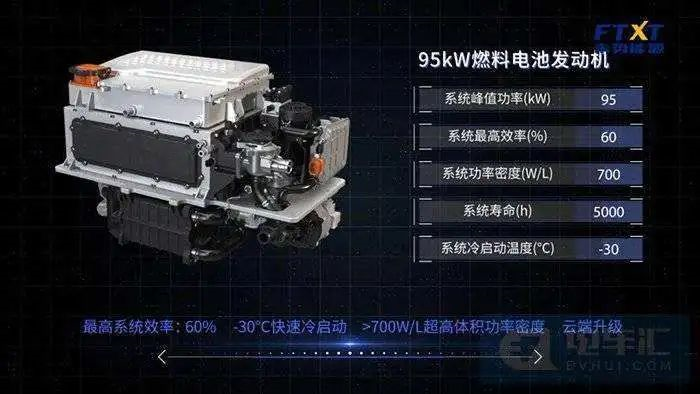Author | Zhu Shiyun
Editor | Wang Lingfang
When talking about Great Wall Motors, people will think of popular models such as Haval H6, Great Wall Cannon, Haval Big Dog, Tank 300…
The accumulation of technology and system in the past 30 years has made Great Wall Motors’ product strategy unstoppable in the traditional fuel vehicle market. However, what is Great Wall Motors’ competitive strategy in the era of intelligent electric vehicles?
“The competition in the new energy field is not only a battle among companies, but also an ecological battle.” On August 22, Mu Feng, the president of Great Wall Motors, explained:
“The new energy industry has an extremely complex industrial chain system. To build a leading advantage, we must create a healthy new energy industrial chain ecological system.”
At Great Wall Motors, this ecological system is called the “forest-style ecological system”. It is a set of ecological systems that focuses on the whole vehicle as its core, comprehensively deploys new energy and intelligent technologies, realizes mutual interaction among multiple species, and continues to evolve.
Compared with other car companies’ and internet companies’ ecological systems, Great Wall Motors’ forest ecological system has its own characteristics:
- It spans the entire value chain of automobiles and even energy;
- It covers multiple new energy vehicle technology routes;
- It crosses into the software field and takes the lead in intelligentization;
- It builds an open and “entropy-reducing” system, allowing species within the ecosystem to survive independently, and maintains the vitality of the ecosystem…
It is necessary to comprehensively analyze Great Wall’s forest ecosystem and the enabling of automotive species within the system. Because it will lead Great Wall Motors to leave the barren land of traditional automobiles and move to the fertile land of intelligent electric vehicles.
From The Sun to Elements
On August 16th, Great Wall landed a special project in Wuxi, Jiangsu Province- a calcium-titanium mine industrial base.
Calcium-titanium is a material for third-generation solar cells. Compared with crystalline silicon and thin-film solar cells, calcium-titanium material has low cost, high efficiency, and short manufacturing processes, which may change the pattern of the entire solar cell industry.
It is unclear when Great Wall started laying out in this promising field. Currently, Great Wall’s Wuxi calcium-titanium mine industrial base plans to build a calcium-titanium photovoltaic component and 100-ton calcium-titanium quantum dots production line. This means that Great Wall’s layout in the field of photovoltaics has reached the mass production stage.
In the complete industrial chain of new energy vehicles, electricity is the most upstream: electric vehicles directly use electricity, and hydrogen fuel cell vehicles can use water electrolysis to produce hydrogen. By laying out calcium-titanium, it means that Great Wall has its own foothold in the energy side of new energy vehicles.# The End of New Energy Vehicle Industry Chain
Solar power generation seems far away from the production and sales of cars, but from the perspective of the entire new energy vehicle ecosystem, the combination of cars and energy will become increasingly close. How to obtain clean and affordable electricity may also become an important competitive advantage for new energy vehicle players.
What is the end of the new energy vehicle industry chain?
Undoubtedly, it is the recycling and utilization of scrapped cars. In the field of new energy vehicles, the emphasis is on the recycling of power batteries.
Great Wall Motors has set up 186 power battery recycling points nationwide, as it is required by the Ministry of Industry and Information Technology for new energy vehicle production companies to establish recycling points. The companies that really carry out recycling, processing, and reuse are power battery companies or recycling companies.
Great Wall Motors has incubated the power battery company, SVOLT Energy Technology, to carry out various businesses centered on power batteries, including power battery material recycling.
At the end of 2021, SVOLT Energy Technology reached a cooperation agreement with BASF to promote a global battery recycling solution. On June 29th of this year, the well-known domestic lithium industry company, Ganzhou Highpower Lithium, announced that it will launch comprehensive cooperation with SVOLT Energy Technology, one of the cooperation focuses is power battery recycling.
Today’s power battery recycling can extract sulfate, lithium carbonate, and other materials, which can be made into cathode precursors and cathode materials, allowing valuable metal elements such as cobalt, nickel, and manganese in the cathode, as well as the lithium element required by the battery, to return to the power battery industry chain.
From the layout of calcium-titanium ore to battery material recycling, it can be seen that the goal of Great Wall Motors’ forest ecosystem is to penetrate the entire industrial value chain – from sunlight to elements, Great Wall Motors has achieved full coverage.
The most crucial part, of course, is related to automobile research and development, supply, and production.
The core part of Great Wall Motors’ forest ecosystem includes advanced vehicle manufacturing processes, various power forms including traditional fuel, pure electric, hybrid, and hydrogen fuel, and wired chassis systems. The upper-level smart cockpit and intelligent driving software and hardware all have proprietary technology capabilities and a comprehensive system layout that is self-developed and self-built.
Great Wall Motors’ full value chain layout model does not mean that it does everything by itself.
Its logic is that Great Wall Motors will control any link that affects the core competitiveness of new energy vehicles.
In the short term, the self-developed and self-produced intelligent and low-carbon capabilities have enabled Great Wall Motors’ products to have the ability to self-supply and be technologically leading in core competitive areas such as intelligent driving, intelligent cockpit, electric, and hybrid power.In the long run, the competition of new energy vehicles will extend to the energy sector, involving upstream costs such as PV layout and hydrogen production, and downstream user experience in the “terminal” section. In addition, the advance deployment in the energy sector will give Great Wall a first-mover advantage in the final stage of new energy.
All-In on Pure Electric, Hybrid, and Hydrogen Fuel Cell Vehicles
There’s no need to doubt Great Wall’s determination to achieve zero-carbon emissions, as it was the first domestic carmaker to publicly propose a timetable for carbon neutrality.
In June 2021, Great Wall announced that it will achieve carbon neutrality by 2045, much earlier than other carmakers with similar goals.
While the goal is the same, the path is different.
Great Wall is not betting everything on pure electric vehicles, but rather on a diversified energy technology route that includes pure electric, hybrid, hydrogen fuel cells, and efficient fossil fuels.
In the forest ecosystem, Great Wall has cultivated a deep and wide soil of low-carbonization technology. This soil has nurtured different species, and they have all begun to blossom and bear fruit.
For the pure electric route, the core components are batteries and electric drives.
Great Wall has laid out power batteries in multiple chemical systems such as lithium iron phosphate, cobalt-free, ternary, and solid-state, and planned three solutions for economic, long endurance, and high performance. It also has the Dayu battery technology, which can effectively suppress thermal runaway, ignition, and explosion of power batteries.
The R&D and production of battery cells are mainly entrusted to Hivenn Energy+ and third-party suppliers. Hivenn and the third-party suppliers complement each other, ensuring both supply and price negotiation advantages and not being subject to anyone’s control.
For electric drive technology, Great Wall is building world-class electric drive products around four dimensions of “integration, high voltage, high speed, and high efficiency,” and constructing M and L platforms with a series of products ranging from 100 kW to 220 kW, which can cover A to D class vehicle models to meet the different power needs of users in various scenarios.
The physical entities of Great Wall’s electric drive system are mainly Hivenn E-Drive and Jinjian Auto. Jinjian Auto, established in 1995, has independently developed or produced or both, including chassis, drive bridges, electronic controlled differentials, electronic brake boosters, and electronic parking systems, forming performance and cost advantages. Meanwhile, Hivenn E-Drive has created its own unique approach to system integration.

In the hybrid field, Great Wall has developed three hybrid systems according to different needs in different scenarios.
The first is the Lemon Hybrid DHT. This system is a leading global solution for high efficiency and high-performance hybrid drive. It addresses the needs of urban commuting while taking into account high-speed travel demand. The high-efficiency hybrid engine and twin-motor hybrid system work together to achieve optimal efficiency in all speed ranges and all scenarios, with the characteristics being highly summarized as “all-speed domain and all-scenario, high efficiency and high performance.”The next is the Lemon Ultimate Performance Hybrid system, which independently developed the world’s first 9-speed hybrid dual-clutch transmission-9HDCT. As the name suggests, the performance hybrid system will provide a stronger performance experience.
The third is the Tank Off-road Super Hybrid Architecture. It uses China’s first vertically placed 9-speed hydraulic automatic transmission-9HAT. It can provide users with power and fuel-saving experience who have off-road needs.
Hybrid systems require efficient engines. This is also a technology that Great Wall Motors has accumulated for a long time. It has independently developed multiple cutting-edge core technologies such as Miller cycle, 350bar high-pressure injection, second-generation CVVL, thermal management technology, gasoline engine particle trap, and other cutting-edge core technologies. The products cover gasoline and diesel engines with mainstream displacements of 1.5L, 1.5T, 2.0T, 2.4T, and 3.0T, forming a low-to-high layout of EG, ED to EB, EN, EC, EZ platforms.
The engine of the Tank Off-road Super Hybrid Architecture is composed of the Great Wall Motors 6Z30 engine and China’s first vertically placed 9-speed hydraulic automatic transmission. It has the three characteristics of strong, efficient, and reliable, and is the first set of completely self-developed high-end powertrains in China.

Hydrogen fuel cell technology is the future power technology layout of Great Wall Motors under carbon neutrality goals.
Great Wall Motors began to develop hydrogen fuel cells in at least 2016 and invested RMB 2 billion in hydrogen energy technology research and development. It established global research and development centers in Baoding, Shanghai, Canada, Japan, and Germany, and formed a core team of 430 people. In 2018, Great Wall Motors also acquired the well-known fuel cell technology company Sunrise Power, further consolidating its R&D strength.
In March 2021, Great Wall Motors’ hydrogen fuel cell technology was unveiled and Hydrogen Lemon Technology was launched. This is a high-performance cost-effective vehicle-level “hydrogen power system” comprehensive scenario application solution, covering hydrogen fuel cell systems, fuel cell stacks, on-board hydrogen storage systems, and core key components, which can support the application of the vast majority of passenger and commercial vehicles.
Great Wall Motors’ “main general” who undertakes the development of hydrogen fuel cell technology is Unisplendour Energy. Its products have been applied in Beijing, Tianjin, Hebei, Shanghai, and many other places, including “Easy Line” sand and gravel transportation, Beijing Xinfadi Agricultural Wholesale Logistics, Tianjin Hydrogen-Powered Green Logistics Transportation, and many other demonstration projects. The planned number of commercial vehicle demonstration vehicles exceeds 1,000, covering multiple fields and types of application scenarios.
Great Wall Motors’ hydrogen strategy not only introduces the “hydrogen power system” for vehicles, but also encompasses an integrated supply chain ecological system of “production, storage, transportation, fueling, and application”. Great Wall Group, as well as Delong Group and Libon Energy, have signed contracts to deepen cooperation in the fields of hydrogen equipment, hydrogen production, hydrogen storage, gas/liquid hydrogen production and transportation, fueling station construction, and zero-carbon logistics, thus forming a complete hydrogen “production, storage, transportation, fueling, and application” industrial ecological closed loop.
“Triple Integration, Triple Independent Development,” is a significant investment for Great Wall Motors. Is it worth it?
From the perspective of technological development, the increasing sales proportion of PHEV and HEV models in the past two years has shown that pure electric and hybrid power are not the ultimate answer to electrification, but rather, is subject to fierce market changes. Multiple technology routes running in parallel mean that companies have flexible adaptability in the face of drastic changes.
In terms of results, Great Wall Motors’ pure electric technology-based Euler and Salon automobiles have outstanding product competitiveness, with Euler, which began mass production earlier, having become a well-known pure electric brand. Weipai and Haval’s hybrid products also lead the industry in product competitiveness and gradually show an advantage in sales.
The layout of the hydrogen fuel cell technology route requires a long-term perspective. Currently, the electrification of pure electric and hybrid solutions relies on the cleanness of the power generation process to form a full-lifecycle decarbonization. The hydrogen fuel cell solution, combined with Great Wall Motors’ perovskite, forms a photovoltaic power generation-electrolytic water hydrogen production-hydrogen fuel cell power generation-electric drive energy full-lifecycle zero-emission closed loop. Although the cost is still high, and many links need to be connected, the overall emission reduction and cost advantages in the future may be highlighted.
At that time, whether the car is driven by hybrid, pure electric, or hydrogen fuel cell systems, Great Wall Motors will not miss out and will have mastery over core competitiveness.
How to Quickly Enter the Second Half of Digitalization?
Electrification is only the initial stage of new energy vehicle competition, while the more advanced and long-term competition lies in digitalization.
For a traditional automaker with substantial accumulation, digitalization faces a dilemma in terms of mode selection. If adopting the traditional supplier model, the differentiation is not strong, and the future still depends on people. If self-developed, the starting point is not high, and talents and mechanisms are not suitable for a software-oriented development mode.
For Great Wall Motors, the application of intelligentization in mass-produced cars adopts a “double-pronged” approach: supplier-provided solutions or components, as well as self-developed solutions. In terms of research and development, active self-development is being carried out, particularly directed towards high-level intelligent driving auxiliary systems with the goal of unmanned driving.Great Wall Motors has three “levers” in the field of intelligence – Haomo Zhixing, Xiandou Intelligence, and Nobo Technology.
Haomo Zhixing undertakes the development strategy of the intelligence of Great Wall Motors, and independently develops a complete intelligent driving solution for Great Wall Motors.
This company, established only two years ago, has developed rapidly and has already achieved mass production of intelligent driving functions that can rival Tesla and XPeng Motors. Within the past few months, Haomo Zhixing’s city NOH system provided for the Great Wall Wei brand Mocha laser radar version will compete with XPeng Motors for the first “crown” of the delivery of city navigation systems.
Haomo Zhixing also has layout in the end-to-end logistics automatic distribution vehicle and intelligent hardware. End-to-end logistics and distribution small car is a scene that directly goes towards fully autonomous driving without drivers, but only explores in a low-speed and closed area. The synergy and mutual empowerment between passenger car terminals and logistics distribution car terminals help Great Wall Motors advance towards high-level intelligent driving assistance.
Compared with intelligent driving assistance, intelligent cabin is more perceptible to consumers. The research and development of Great Wall Motors’ intelligent cabin is led by its subsidiary, Xiandou Intelligence. Its positioning is a technology company focusing on travel scenarios in the era of everything connected. Xiandou Intelligence has built four major business systems, including whole vehicle intelligent products, intelligent marketing multi-terminal integrated products, intelligent service series products, and data intelligence closed-loop platforms.
Regarding intelligent cabin and hardware production for intelligent driving, Great Wall Motors has its subsidiary Nobo Technology, which provides cabin domain controllers, displays, instruments, information entertainment systems, central electronic units, T-BOX, driving domain controllers, and other products for Great Wall Motors and other automakers.
So far, as a traditional independent brand, Great Wall Motors is exploring intelligence in the forefront with new forces and new brands. For example, Great Wall Motors’ Coffee Intelligent Driving system leads domestically in the coverage of scenarios and mass production, and supports HWA (Highway Assist), NOH (Intelligent Navigation Assist), and City NOH (City Intelligent Navigation Assist) functions, which is the highest level in the industry, L2 + function.
It is worth noting that the intelligence leading of Great Wall Motors in terms of functionality and experience has its profound technical foundation. In order to support high-level intelligent driving and intelligent cabin, Great Wall Motors has also developed a new electronic and electrical architecture, wire-controlled chassis, and cabin operating system. This makes the intelligence of Great Wall Motors achieve decoupling of software and hardware, continuous rapid iteration, high security redundancy, strong compatibility, and strong scalability.Insight into the Intelligent Electric Vehicle Technology Layout of Chinese Auto Enterprises
Some Chinese auto enterprises focus on intelligentization but lack electrification. Others, however, focus on electrification and lack intelligentization. Great Wall Motor, on the other hand, has made deep inroads into both fields, and has begun large-scale commercial applications. When resisting competitors like Tesla, which are strong in both intelligence and electrification, Great Wall Motor can fight on two fronts.
The “Racehorse” System
Although it has formed a multi-pronged, multi-technology and symbiotic eco-system, Great Wall Motor is not complacent. On the occasion of the company’s 30th anniversary celebration in July 2020, Wei Jianjun, the head of Great Wall Motor, issued a warning: Can Great Wall Motor make it through next year?
“Although building an ecosystem under the umbrella of Great Wall Motor seems easy, what is difficult is to keep the ecosystem vibrant and evolving, allowing independent species to survive. Otherwise, it is like a tiger raised in a zoo, which appears majestic but dies out in the wild.”
To address this issue, Great Wall Motor’s strategy is to “invite in” and “go out”. “Inviting in” means opening up parts procurement to the outside world, inviting competitors to race with them. “Going out” means that Great Wall’s subsidiaries also need to seek supply opportunities from other auto companies and seek external supply.
A typical example is Honeycomb Energy. Founded at Great Wall Motor’s Power Battery Business Unit, Honeycomb Energy may not necessarily obtain all power battery orders from Great Wall Motor.
Great Wall Motor has already established procurement relationships with companies such as CATL and ProLogium. In 2021, Great Wall Motor signed a ten-year strategic cooperation framework agreement with CATL and a purchase agreement with ProLogium, agreeing to purchase a total of not less than 10GWh worth of batteries from ProLogium from 2022 to 2025.
Honeycomb Energy is also pushing outward. Starting in 2022, its external supply will gradually increase. This year, it plans to reduce the proportion of deliveries to Great Wall Motor to below 50%. By 2025, Honeycomb Energy plans to build a production capacity of 600GWh, of which only 30% is planned to be supplied to Great Wall Motor, while the rest will be supplied externally.
Honeycomb Energy has already signed more than 30 fixed-point projects, including Dongfeng Motors, FAW Motors, Geely, Hezhong New Energy, Siles and Leapmotor.
As Honeycomb Energy comes from Great Wall but does not rely on it, it has become a hot target in the investment market. After a new round of capital increase in February of this year, Honeycomb Energy’s valuation has reached 46 billion yuan, and it is currently preparing to go public.This case of Foton shows that the ecological naming of Great Wall Motors as “Forest” means that species in the ecology cannot “stand alone”, but must coexist, share and advance together, and ultimately “grow into a forest” to withstand all kinds of challenges.
When automobiles enter the era of smart electric vehicles, when internet giants such as Apple, Huawei, and Xiaomi come to the door of the automobile, many people believe that these internet giants will upgrade the battle of automobiles, and with the ecological advantage, they will strike against traditional automotive plants, winning an overwhelming victory.
The future of new energy vehicles is indeed an ecological battle, but this statement is clearly biased.
Outside the ecology of applications, entertainment, content, and other areas where the Internet and smart terminals excel, there are also ecological factors such as energy, materials, components, production, consumption, service, and recycling. In this ecology, Great Wall Motors, which has been working hard for a long time, is well-prepared.
Just like the king of the grassland going head to head with the lord of the forest, the outcome is still unknown.
–END–
This article is a translation by ChatGPT of a Chinese report from 42HOW. If you have any questions about it, please email bd@42how.com.
